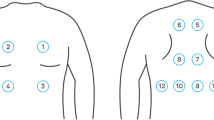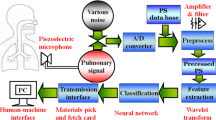Abstract
Respiratory sounds are of significance as they provide valuable information on the health of the respiratory system. Sounds emanating from the respiratory system are uneven, and vary significantly from one individual to another and for the same individual over time. In and of themselves they are not a direct proof of an ailment, but rather an inference that one exists. Auscultation diagnosis is an art/skill that is acquired and honed by practice; hence it is common to seek confirmation using invasive and potentially harmful imaging diagnosis techniques like X-rays. This research focuses on developing an automated auscultation diagnostic system that overcomes the limitations inherent in traditional auscultation techniques. The system uses a front end sound signal filtering module that uses adaptive Neural Networks (NN) noise cancellation to eliminate spurious sound signals like those from the heart, intestine, and ambient noise. To date, the core diagnosis module is capable of identifying lung sounds from non-lung sounds, normal lung sounds from abnormal ones, and identifying wheezes from crackles as indicators of different ailments.











Similar content being viewed by others
References
Statistics Canada, selected leading causes of death, report 1997.
American Lung Association, Data and Statistics, State of Lung Disease in Diverse Communities, Lung Disease Data at a Glance: Influenza and Pneumonia, report 2007.
Jeremy, P. T., Ward, J. W., Leach, R. M., and Wiener, C. M., The respiratory system at a glance, 2nd edition. Blackwell Publishing, USA, 2006.
Jan, R., Cortes, S., Fiz, J. A., and Morera, J. Analysis of wheezes in asthmatic patients during spontaneous respiration. Conference Proceedings. 26th Annual International Conference of the Engineering in Medicine and Biology Society, Volume 2, 2004, pp. 3836–3839, 2004.
Pasterkamp, H., Kraman, S., and Wodicka, G. R., Respiratory sounds advances beyond the stethoscope. Am. J. Respir. Crit. Care Med. 156(3):974–987, 1997.
Polat, H., and Guler, I., A simple computer-based measurement and analysis system of pulmonary auscultation sounds. J. Med. Syst. 28(6):665–672, 2004. December.
Schuttler, F., Penzel, T., Von Wiichert, P. Digital recording and computer-based analysis of lung sounds. 18th Annual lnternational Conference of the IEEE Engineering in Medicine and Biology Society, Amsterdam 1996.
Mansy, H. A., Royston, T. J., Balk, R. A., and Sandier, R. H., Pneumothorax detection using computerized analysis of breath sounds. Med. Biol. Eng. Comput. 40:526–532, 2002.
Alsmadi, S. S., and Kahya, Y. P. Online classification of lung sounds using DSP. Proceeding of the Second Joint EMBS/BMES Conference, Houston, TX, USA, October 2003.
Kahyq, Y. P., Cini, U., and Cerid, O. Real-time Regional respiratory sound diagnosis instrument. Proceedings of the 25th Annual International Conference of the IEEE EMBS, Cancun, Mexico, 2003.
Moussavi, Z. K., Leopando, M. T., Pasterkamp, H., and Rempel, G., Computerized acoustical respiratory phase detection without airflow measurement. Med. Biol. Eng. Comp. 38(2):198–203, 2000.
Yeginer, M., Ciftci, K., Cini, U., Sen, I., Kilinc, G., and Kahya, Y. P. Using lung sounds in classification of pulmonary diseases according to respiratory sub-phases. Proceedings of the 26th Annual International Conference of the IEEE EMBS, San Francisco, CA, USA, 2004.
Mazic, I., Sovilj, S., and Magjarevic, R. Analysis of respiratory sounds in asthmatic infants. Meas. Sci. Rev. 3(2), 2003.
Gross, V., Penzel, T., Hadjileontiadis, L., Koehler, U., and Vogelmeier, C. Electronic auscultation based on WAVELET transformation in clinical use. Proceedings of the Second Joint EMBS/BMES Conference, Houston, TX, USA, 2002.
Kandaswamy, A., Kumar, C. S., Ramanathan, R. P., Jayaraman, S., and Malmurugan, N., Neural classification of lung sounds using wavelet coefficients. Comput. Biol. Med. 34(6):523–537, 2004.
Sovijärvi, A. R., Malmberg, P. L., Charbonneau, G., Vanderschoot, J., Dalmasso, F., Sacco, C., Rossi, M., and Earis, J. E. Characteristics of breath sounds and adventitious respiratory sounds. Eur. Respir. Soc. J., 2000.
Pasika, H., and Pengelly, D. Lung sound crackle analysis using generalised time-frequency representations. Department of Electrical Engineering. McMaster University, Canada Department of Engineering Physics and Department of Medecine, McMaster University Canada.
Springhouse, Auscultation skills: breath & heart sounds. Lippincott Williams & Wilkins, Philadelphia, USA, 2006.
Lehrer, S., Understanding lung sounds. W.B. Saunders, Philadelphia, 2002.
Murphy, R. L. H., and Murphy, M. A., Learning lung sounds. Stethographics Inc., Westborough, 2001.
Freeman, J. A., and Skapura, D. M. Neural networks algorithms, applications, and programming techniques. Addison-Wesley Publishing Company, 1991.
Clifford, L. Neural networks: theoretical foundations and analysis. IEEE Press, Page(s) 26–53, 211–221, 1992.
Author information
Authors and Affiliations
Corresponding author
Rights and permissions
About this article
Cite this article
Abbas, A., Fahim, A. An Automated Computerized Auscultation and Diagnostic System for Pulmonary Diseases. J Med Syst 34, 1149–1155 (2010). https://doi.org/10.1007/s10916-009-9334-1
Received:
Accepted:
Published:
Issue Date:
DOI: https://doi.org/10.1007/s10916-009-9334-1




